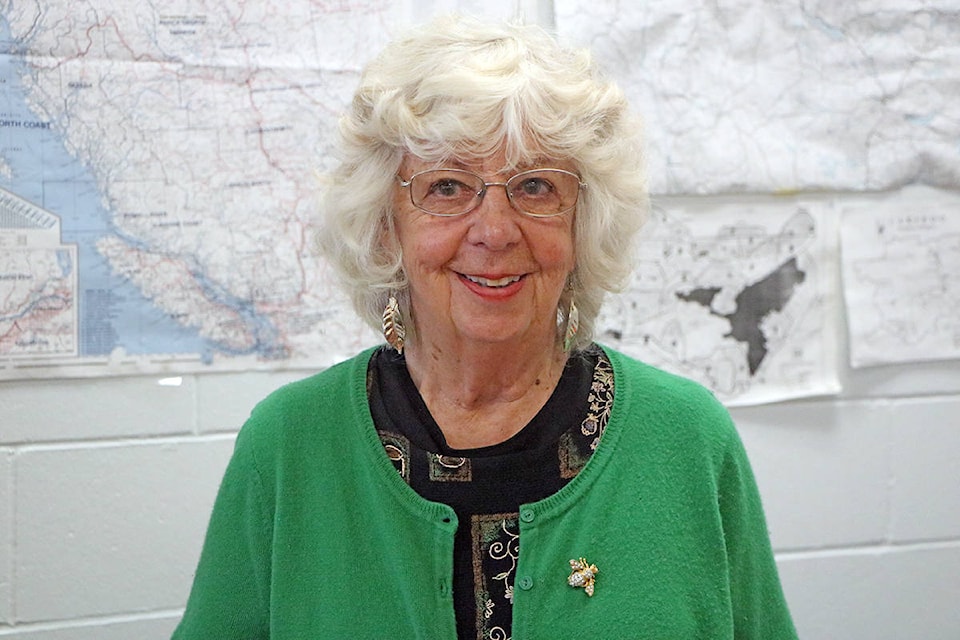By Marianne Van Osch
High on a hillside above Forest Grove, in a clearing in the woods, the only sounds to be heard are the whispers of aspen leaves, a trilling of bird songs and a squirrel chirring nearby. A warm breeze dances with tall purple lupines. The school children arrive. They are quiet and eager to find out what this is all about.
This place of beauty and serenity is the Forest Grove Cemetery. It is almost one hundred years since Thomas Auld, at 14, was chasing a cow home when he fell on the road and was killed by the gun he was carrying. Rather than bury Thomas near the family’s home as was often done, the family decided to put him at the edge of their land. He was a wanderer and a bird lover who went through here on his adventures. The cemetery grew around him.
The cemetery tour is part of a class project. Mrs. Babicky and her students have researched the history of Forest Grove as one of the earliest settlements in the Cariboo. They are delighted to recognize pioneer names on headstones: Wilcox, Hendrix, Judson, Redpath and Rhodes.
We go to the oldest section of the cemetery where some gravesites have been lost to time and tree roots. There are three headstones sitting far apart in the uneven ground under the trees. There are no dates or details on these plain markers, just Granny Smith, O.W. Brown and Grandpa Hardman. A fourth states Mrs. Lord Died, 1950. We decide that these folks must have been no-nonsense, independent pioneers.
Nearby is Thomas Auld, 1913-1927. We notice cornerstones that were once part of a fence around his grave and the large Auld family plot. White picket fences were common years ago in cemeteries.
Some of the graves have covers that are made of cement with inlaid pebbles. The class notices that “Mother” or “Father” are common inscriptions on the covers. One site is covered with fist-sized stones, an ancient custom that shows respect for the person being visited.
The young people are a thoughtful group. They carefully brush the debris away from headstones. One girl straightens a vase of flowers that has tipped over. They notice the dates of passing and calculate ages. There are a number of children in the cemetery. A small red wagon has sat on a headstone for many years. On another, there is no date, just a name and a tiny lamb. It is suggested that medical care was not always available years ago.
They are curious about one small stone between two large ones. I tell them that the stone honours Cash Bourgeois. Cash was a Forest Grove boy who never returned from World War II. During the tour, the children find other military markers.
Many old stones have been replaced or updated. More recent ones refer to the person’s interests or occupation and are illustrated. “Sailed Home,” Our Digger Man,” and “See You In Shangrila” are just a few of many intriguing captions. One headstone tells us that a man loved to play hockey. His two sons are nearby and were also hockey players.
At the end of the tour, the children are told to pick a wildflower to place on the headstone of a person they will remember. They spread out to the edges of the cemetery and return to place their flower on the grave they have chosen.
A few years ago Zita Jones, a little girl who was placing a bouquet of flowers on a headstone, turned to the other children and said, “Isn’t this is a lovely place to rest!” And so it is.
In the warmth of the afternoon sun, the group gathers at the large saw blade that was donated to the cemetery by the Walters family. A photo is taken and off they go, down the hill with its lovely view toward Canim Lake and beyond.
To visit the Forest Grove Cemetery turn onto Shaw Drive just before the school. Shaw Drive becomes Auld Road then climbs up to the cemetery.
